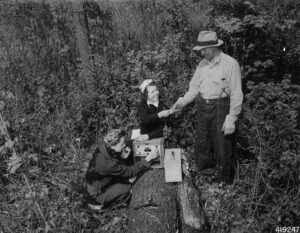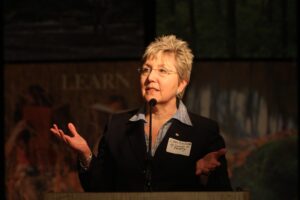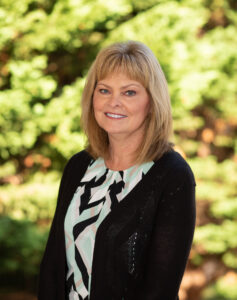By Hannah Wagner
We have an exciting announcement to make! Right now, there are more women leading state forestry agencies than ever before. Thirteen female state foresters out of a total of 59 might not seem like a triumph, but it is.
The forestry sector has historically been a male-dominated profession, and even today, fewer than 20% of foresters in the United States are female. While we have a long way to go before realizing equal gender representation in the field of forestry, we’ve come a long way, and it’s important we recognize it. Before Women’s History Month comes to end, join us in celebrating what progress we’ve made (and consider with us how we can keep it going!).
WHERE WE WERE
Before and throughout the early twentieth century, women in the U.S. were largely excluded from most professions. Limited to gender appropriate roles, the 28% of American women who worked outside of the home in 1940 in conservation primarily earned their paychecks as clerks, typists, librarians, and researchers.[1] Their exclusion from professional forestry, however, didn’t keep women from making an impact.
It wasn’t uncommon in the early 1900s for the wives of U.S. Forest Service rangers to serve as clerks for no pay, helping their husbands with field duties and preparing fire reports by estimating timber losses and analyzing fire causes. Women also served as fire tower lookouts, nurses, and camp cooks on the fire lines.[2] Particularly during World War II, women stood in for men on fire crews and routinely cruised timber; but it wasn’t until three decades later, in 1978, that women would be allowed to hold field positions with the Forest Service.[3]

“Working in the field or on the fire line were the two fastest ways to climb the company ladder, and women weren’t allowed even on the first rung, except in times of crisis.”[4]
Among state forestry ranks, women were largely absent or similarly marginalized until the 1970s. From 1920 to 1960, the only women mentioned or pictured in connection with the National Association of State Foresters were those who joined their husbands at NASF annual meetings on field tours of local forestry projects.
In the 1960s, the wives of state foresters formed an official Foresters’ Wives Club to keep in touch with one another between annual gatherings. The club’s members would organize annual meeting dinners and activities, coordinate news coverage of NASF meetings with local newspapers, and arrange day tours “for the ladies” in attendance.[5]
In the late 1960s and early 1970s, more women began entering the forestry sector, but mostly as researchers or secretaries. And by the late 1970s, gender discrimination bans and civil rights legislation were in place and enforced, allowing for a boom in women’s employment, including in the forest sector and other natural resource professions.
HOW FAR WE’VE COME

Women didn’t ascend to the highest government leadership positions in forestry until the 1990s. The first female state foresters, Susan Bell and Kaleen Cottingham, were both appointed in 1992. Maine State Forester Bell previously served as the deputy commissioner of the Maine Department of Conservation from 1987 to 1992 and three terms in the Maine House of Representatives from 1980 to 1986.
Cottingham served as the natural resources policy advisor and legal counsel for Washington Governor Booth Gardner before becoming the Washington state forester. She went on to serve as supervisor of Washington’s Department of Natural Resources, Washington’s deputy commissioner of public lands, and director of Washington’s Recreation and Conservation Office.
In 2007, the Forest Service named its first female chief, Gail Kimbell. Kimbell holds two forestry degrees and spent her entire career in forestry, mostly in the Northwest U.S. Soon after, in 2008, NASF elected its first female president. Leah MacSwords, who was also the first woman to be Kentucky’s state forester and the first NASF president to hail from Kentucky, did not have a forestry background like many of her male predecessors. Instead, MacSwords was an expert in management and governmental regulation, and she put that acumen to work with the NASF, pursuing increases in federal funding to support and promote sustainable forestry.[6]
In 2018, NASF elected its second female president. Lisa Allen, then the state forester of Missouri, began her career with the Missouri Department of Conservation as an assistant resource forester in 1984. She served as forest management chief, forestry field programs supervisor, resource forester, and private lands services division chief with the department before being named state forester in 2006. Allen holds two forestry degrees, and in 2021, was chosen as the namesake for the “NASF Lisa Allen Current Achievement Award for Leadership.”
HOW DO WE ENCOURAGE MORE WOMEN TO JOIN THE FOREST SECTOR?

I. Through school-based outreach.
According to a presentation from the 2019 Society of American Foresters’ National Convention, women make up 60% of undergraduate students enrolled in environmental programs, but only 23% of students enrolled in forestry programs. Forestry colleges across the country have implemented programming to address this gender gap. To give just one example: the Supporting Women in Forestry Today (SWIFT) program at the University of Maine’s School of Forest Resources holds three to four events a semester to support women in pursuing forestry education and careers.

II. Through equity and inclusivity initiatives.
The growing number of female forestland owners alone demands notice from the forest sector at large. Just in the last two years, the Women’s Forest Congress has expanded its role as a forum for women landowners, managers, and forest stakeholders to connect and share ideas on the future of forests. The group has held numerous virtual events and will hold its inaugural in-person conference in October. Other initiatives, including Women Owning Woodlands and Women and Their Woods, are working to connect female forestland owners directly with forest management experts.
III. By listening to women in forestry.
Perhaps the best way we can encourage more women to pursue forest stewardship or a career in forestry is to listen to the experiences and consider the advice of women currently in forest leadership.
To this end, NASF asked our female state forester members to answer a few questions about their own careers in forestry, why diversity is important in the workplace, and what they are looking forward to in 2022. Here are some of their responses edited for clarity:

Q: What inspired you to pursue a career in forestry?
Kacey KC (Nevada State Forester): “I grew up wandering in the woods and being fascinated by everything I saw. I wanted to work in forestry to make sure that we could conserve these beautiful areas and the memories and life lessons they provide for generations to come.”
Heather Berklund (Wisconsin State Forester): “I spent most of my youth roaming the outdoors in the beautiful driftless area of southwest Wisconsin, walking the woods, picking berries and mushrooms, playing in the creek, cutting firewood, and observing the wildlife. I didn’t know that forestry was a career choice, but I always knew I didn’t want a job sitting inside all day. As I began searching for schools with an environmental focus, I landed on the University of Wisconsin-Stevens Point. After taking my basic natural resources introductory courses, I was drawn to forestry, because trees truly are the answer to the overall health of our environment and provide so many benefits to people and our landscapes. Who wouldn’t want to work with trees?”
Anne Hairston-Strang (Maryland Acting State Forester): “Family camping trips around the country showed me amazing natural places, and I wanted to learn more about how the natural world worked. On choosing between geology, environmental science, and forestry for a career: I wanted to be part of a renewable resource industry and contribute in tangible ways to meet people’s needs, so I chose forestry.”
Q: Which of your professional accomplishments are you most proud of?
Heather Berklund (Wisconsin State Forester): “I am proud of the relationships I have built. I still have landowners who reach out to tell me how much they appreciated what I taught them; and industry folks and partners who comment on my practical, common-sense approach to working with people and the resources. I am proud to have spent time with coworkers managing the woods, suppressing wildfires, and responding to natural disasters—we all share a passion for serving the public. Finally, I am so proud and honored to be the first woman state forester in Wisconsin and grateful for all the forestry community’s support. I hope I inspire others to want to pursue a career in forestry.”
Patty Cormier (Maine State Forester): “I’m proud of the many connections I have made throughout my career. You just never know who you will be working with or for. Having maintained so many healthy connections, I pat myself on the back.”
Q: What advice would you give to a woman interested in a forestry career?
Kacey KC (Nevada State Forester): “Go for it. It is such a rewarding field to work in both personally and professionally. Be patient, be strong, and always be you.”
Patty Cormier (Maine State Forester): “The field has opened up for women. My advice is to take every opportunity given to learn, to listen, to work with those who have forged the way, and to develop your own set of unique qualifications that will make you invaluable.”
Heather Berklund (Wisconsin State Forester): “Seek out peers and support networks. There will be times that you will feel excluded or like you have to explain your worth. Find ways to get involved with your organization so that your perspectives and skills are captured and utilized. Imposture syndrome can be real for many women, and you may not feel like you have the qualifications or skills to take that ‘next step’ in your career, so learn to have confidence in your abilities and understand the value you contribute. Be willing to take some risks and share your story so others can learn and grow. Never stop learning, listening, and asking questions.”
Q: In your opinion, what are the top forestry challenges your state currently faces?
Ellen Shultzabarger (Pennsylvania State Forester): “Keeping forests as forests is a top challenge; as well as keeping those forests healthy and resilient to climate change, forest pests, and invasive species.”
Kacey KC (Nevada State Forester): “The top challenges we face in Nevada are catastrophic wildfires and the subsequent loss of native vegetation to invasive, fine, and flashy fuels. We need more resources to do the management work necessary to creating resilient landscapes and to employ the wildfire suppression workforce we need to address our growing fire issue.
Q: What (or who) inspires or motivates you the most?
Patty Cormier (Maine State Forester): “I am absolutely motivated by all the dedicated natural resource managers, landowners, and even politicians that work so hard every day to improve and maintain natural resources and educate others. This is a big part of what keeps me going in the field of forestry. Also, when I’m on the receiving end of appreciation for work well done, it’s like a fresh cup of coffee, providing warmth and energy to keep going.”
Ellen Shultzabarger (Pennsylvania State Forester): “My children. And that my work is to maintain and restore forests for my children and future generations.”
Q: What are you excited about, professionally or personally, in 2022?
Ellen Shultzabarger (Pennsylvania State Forester): “I look forward to reconnecting with people—and getting back to talking with and seeing people as we plant, care for, and celebrate trees and forests!”
Anne Hairston-Strang (Maryland Acting State Forester): “Maryland is hosting the 100th annual Society of American Foresters meeting in Baltimore this September! We have lots to showcase here in the Mid-Atlantic.”
Patty Cormier (Maine State Forester): “Professionally, I am excited for the focus on climate change and the inevitable conversation that follows on the value of keeping our forests as forests. I believe this is our day as forest stewards to capitalize on the growing interest both nationally and locally in forests; to educate and bring awareness to how fortunate we are to have them.”
Q: Why does diversity in the workplace matter to you?
Anne Hairston-Strang (Maryland Acting State Forester): “We need to have diverse skills and perspectives in our organizations to generate a range of potential solutions. We don’t know what we don’t know.”
Kacey KC (Nevada State Forester): “The resiliency of an agency is dependent on diverse backgrounds and beliefs. They keep an agency fluid, current, and always moving forward.”
Heather Berklund (Wisconsin State Forester): “A workplace where there is mutual respect and inclusivity is a space where people can be their authentic selves, more fulfilled in their work, and ultimately, more productive. We all see how a diverse forest flourishes and survives the test of time; a diverse forestry workforce can do the same!”
Hannah Wagner, NASF’s communications coordinator, can be reached by email at hwagner@stateforesters.org.

